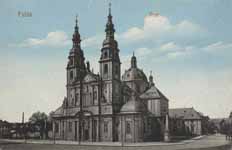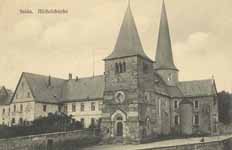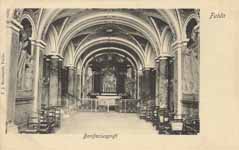.






7, 8, 9,
10, 11,
Fulda
Fulda (German pronunciation: [ˈfʊlda]) is a city in Hesse, Germany; it is located on the river Fulda and is the administrative seat of the Fulda district (Kreis).
History
Early Middle Ages
The Benedictine monastery of Fulda was founded in 744 by Saint Sturm, a disciple of Saint Boniface, as one of Boniface's outposts in the reorganization of the church in Germany. It later served as a base from which missionaries could accompany Charlemagne's armies in their political and military campaign to fully conquer and convert pagan Saxony.
The initial grant for the abbey was signed by Carloman, the son of Charles Martel. The support of the Mayors of the Palace and later, the early Pippinid and Carolingian rulers, was important to Boniface's success. Fulda also received support from many of the leading families of the Carolingian world. Sturm, whose tenure as abbot lasted from 747 until 779, was most likely related to the Agilolfing dukes of Bavaria. Fulda also received large and constant donations from the Etichonids, a leading family in Alsatia, and the Conradines, predecessors of the Salian Holy Roman Emperors. Under Sturm, the donations Fulda received from these and other important families helped in the establishment of daughter houses Johannesberg and Petersberg near Fulda.
St Boniface baptizing and being martyred, from the Sacramentary of Fulda
After his martyrdom by the Frisians, the relics of Saint Boniface were brought back to Fulda. Because of the stature this afforded the monastery, the donations increased, and Fulda could establish daughter houses further away, for example in Hamelin. Meanwhile Saint Lullus, successor of Boniface as archbishop of Mainz, tried to absorb the abbey into his archbishopric, but failed. This was one reason that he founded Hersfeld Abbey, to limit the attempts of the enlargement of Fulda.
Between 790 and 819 the community rebuilt the main monastery church to more fittingly house the relics. They based their new basilica on the original 4th-century (since demolished) Old Saint Peter's Basilica in Rome, using the transept and crypt plan of that great pilgrimage church to frame their own saint as the "Apostle to the Germans". The crypt of the original abbey church still holds those relics, but the church itself has been subsumed into a Baroque renovation. A small, 9th century chapel remains standing within walking distance of the church, as do the foundations of a later women's abbey.
The great scholar Rabanus Maurus was abbot from 822 to 842.
From its foundation, the abbey Fulda and its territory was based on an Imperial grant, and therefore was a sovereign principality subject only to the German emperor. Fulda was made a bishopric in 1752 and the prince-abbots were given the additional title of prince-bishop. The prince-abbots (and later prince-bishops) ruled Fulda and the surrounding region until the bishopric was forcibly dissolved by Napoleon in 1802.
The city went through a baroque building campaign in the 18th century, resulting in the current “Baroque City” status. This included a remodeling of the Dom (Cathedral) of Fulda (1704–1712) and of the Stadtschloss (Castle-Palace, 1707–1712) by Johann Dientzenhofer. The city parish church, St. Blasius, was built between 1771–1785.
In 1764 a porcelain factory was started in Fulda under Prince-Bishop, Prince-Abbot Heinrich von Bibra, but shortly after his death it was closed down in 1789 by his successor, Prince-Bishop, Prince-Abbot Adalbert von Harstall. Because of its quality and rarity, this porcelain is much prized by collectors.
Cold War importance
Fulda lends its name to the Fulda Gap, a traditional east-west invasion route used by Napoleon and others. During the Cold War, the former East/West German border passed just east of Fulda, and large Soviet and East German forces were stationed in the area as it was considered to be a potential invasion route against the German Democratic Republic and the Eastern bloc countries generally.
The U.S. Army stationed the 14th and later the 11th Armored Cavalry Regiments in the city and surrounding areas as the screening force for the U.S. V Corps.
International relations
See also: List of twin towns and sister cities in Germany
Twin towns — sister cities
Fulda is twinned with:
Italy Como, Italy (1960)
France Arles, France (1964)
Russia Sergiyev Posad, Moscow Oblast, Russia (1991)
United States Wilmington, Delaware, USA (1997)
Czech Republic Litoměřice, Czech Republic (2001)
People
Adam of Fulda
Tobias Sammet
Martin Hohmann
Ferdinand Braun
Sebastian Kehl
Franz Kaspar (or Caspar) Lieblein
Max Stern
Dirk Sauer
Fr. Gereon Karl Goldmann
Edguy
Images
Cathedral of Fulda.
Statue of Saint Boniface (1830) in Fulda.
Fulda, 1850
"Stadtschloss" (main entrance) at Fulda.
Old City Hall of Fulda.
Orangerie.
Kloster Frauenberg (Fulda), a Franciscan monastery.
St. Michael's Church.
Baroque Adelspalais.
Old University of Fulda: Adolphs-Universität Fulda.
Looking east toward Fulda over the rich farmlands.
Weser river watershed, showing Fulda River and the city of Fulda.
References
^ "Die Bevölkerung der hessischen Gemeinden" (in German). Hessisches Statistisches Landesamt. June 2011.
From Wikipedia, All text is available under the terms of the GNU Free Documentation License

